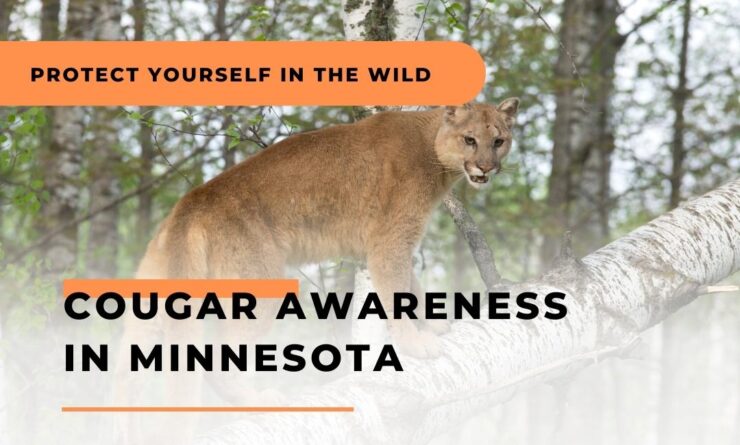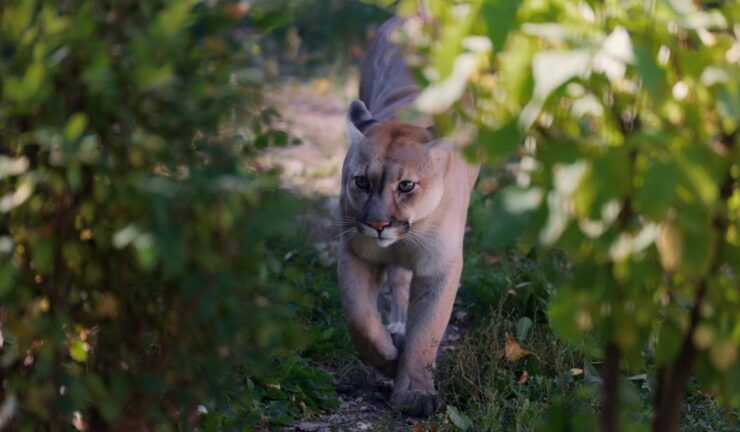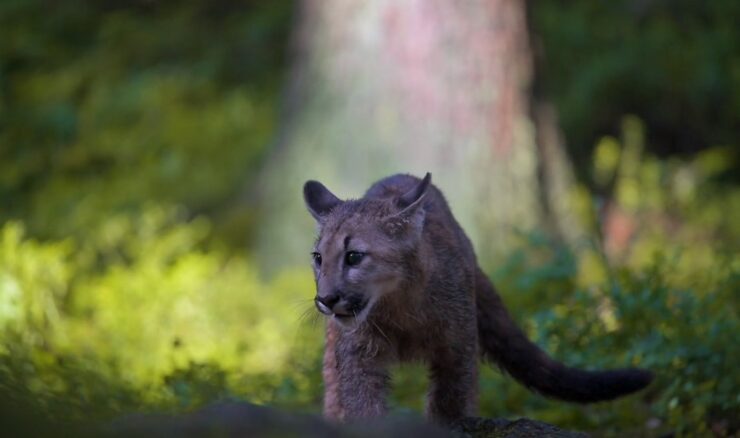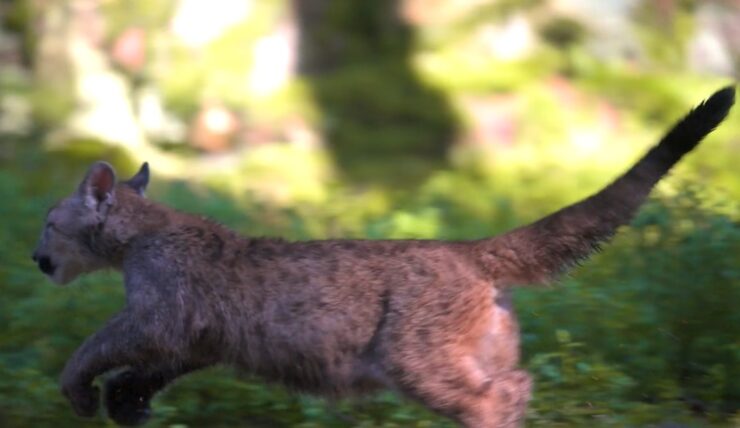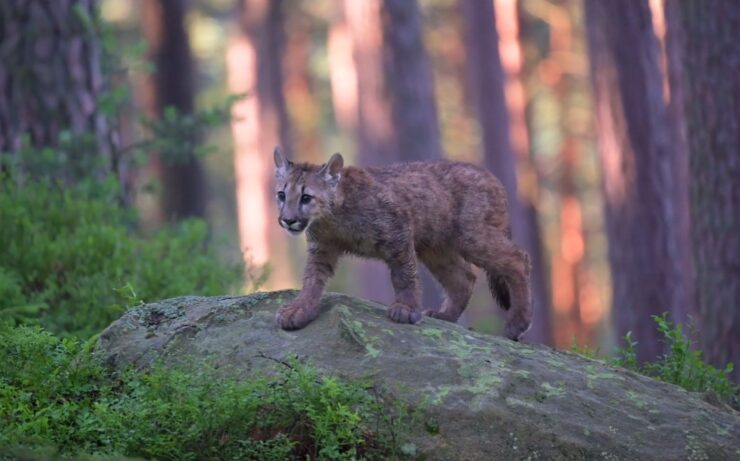Minnesota is home to a variety of wildlife, including cougars, also known as mountain lions. These majestic animals are typically elusive and avoid contact with humans, but occasionally encounters do happen. If you happen to come across a cougar in Minnesota, it’s essential to know how to react appropriately to stay safe.
In this article, we’ll discuss what to do if you spot a cougar in Minnesota, how to recognize the signs of a cougar presence, and what precautions you can take to prevent a cougar encounter. Whether you’re a hiker, camper, or resident of Minnesota, this guide will provide you with valuable information to keep yourself and others safe in cougar country.
Know What to Look For
Spotting a cougar in Minnesota is a rare occurrence, but it can cause fear and panic in the moment. In order to effectively handle a situation involving a cougar, it is important to be aware of what to look for.
Knowing the characteristics of a cougar, and how to respond to one, can help keep yourself, and those around you, safe.
Identify the Cougar
It is important to be able to identify a cougar if you think you may have seen one. They are usually tan or light brown, with long tails and pointed ears. They are typically two to three feet tall at the shoulder and weigh from 80 to 230 pounds. If you do see a cougar, remain calm and watch it from a distance and never approach or try to interact with it in any way.
To help identify the animal correctly, take note of distinguishing characteristics like size and coloration. If possible, take photos or video recordings of the animal; these can provide evidence that will help scientists determine whether the animal really is a cougar and if it has been previously recorded in the area.
Also document information such as what time of day the animal was spotted, where you observed it, its general direction of movement after sighting—and even your feelings during the encounter (was there an aggressive behavior displayed). This information can be critical for wildlife management officials trying to learn more about this elusive species.
Learn the Behavior of Cougars
It is important to know that they are generally shy and reclusive animals that usually avoid contact with humans. Cougars will usually express submission when confronted by a human, often turning away and crouching down to the ground in an attempt to make themselves look as small as possible.
If you spot one, it is best to stay calm and not run away — they may interpret this behavior as aggression or a sign of prey. Instead, you should stand your ground and make yourself appear larger by waving your arms or opening your coat. Speak in a firm, loud voice to alert the animal. Make sure it has an escape route and that it can see you at all times — if the cougar has no escape route it may feel threatened and become aggressive.
Never turn your back on a cougar if you come across one in Minnesota — if possible, back away slowly while keeping eye contact.
Stay Calm
Encountering a cougar in the wild is a rare and intimidating experience, but it’s important to remain calm. However, this doesn’t mean that you should stay and try to interact with the cougar.
Let’s look at some steps you should take if you spot a cougar.
Remain Calm and Don’t Run
It is important to remain calm and refrain from sudden movements if you should spot a cougar in Minnesota. They may perceive fleeing humans as prey and this can lead to an attack. Do not turn your back on the animal, instead, stand sideways and maintain eye contact with the cougar if possible. Speak firmly and confidently, but do not make yourself overly loud or aggressive as this could further agitate the cougar. Back away slowly and never run as this could trigger a chase response that has a very high probability of leading to an attack.
If you are walking or hiking alone in areas where they are known to live or frequent, make yourself appear bigger by using sticks, jackets, or hiking poles. If the animal follows you at all during your escape attempt, continue to make noise, wave your arms around, and throw items in the direction of it without making eye contact with it – all without running or turning away from it suddenly. If the animal appears to be displaying signs of aggression such as lifting its lip corners, snarling, or growling – make sure that you are positioned facing the animal so that it never gets close behind you.
If you have children in your group tell them to hide behind objects if needed for safety reasons – do whatever is necessary for everyone’s safety if an attack does happen.
Don’t Make Eye Contact
Do not make eye contact with the cougar as this is seen as a challenge or threat and may further agitate it. Back away slowly, if possible, while keeping the cougar in sight. Speak calmly and firmly as you move away. You want the cougar to understand that you are not attacking them and they should also keep their distance from you. Avoid sudden movements and if the cougar follows or continues to advance toward you, do not run! Running will just trigger its chase instinct, however, if it begins to advance on you again then raise your arms or throw sticks/rocks in its direction in an attempt to scare it away.
Move off slowly – when given an opportunity to retreat but still remain aware of your surroundings for further signs of danger, such as more than one animal on the scene or a potential den area nearby.
Determine Your Distance from the Cougar
The next thing you need to do is determine your distance from the cougar.
If you are too close to the cougar, it may become agitated and attack. However, if you are far enough away, you can safely observe the cougar or, if possible, get away from the area quickly.
Estimate the Distance
An adult cougar can lurk in tall grass or keep hidden behind trees and bushes, making it hard to tell how close the animal is. They impassively stalk their prey, so if you feel like you’re being watched by one, careful observation is essential. A cougar won’t typically attack unless provoked or feeling threatened, but they are capable of sprinting up to 40 miles per hour and will do so if they have identified you as prey.
When estimating the distance between yourself and a cougar, pay attention to the signs that indicate whether or not the animal feels threatened. A cougar will usually keep its head low when relaxed as well as show loose facial muscles — while aggressive animals will have their head held high with eyes focused on you and ears pointed forward. It’s best to start backing up slowly until you can no longer see the animal and then make your way to safety with caution.
Estimating distances can be difficult given that cats look much closer than they actually are due to their small size relative to humans; even from 100 feet away, a cougar can appear much closer than it actually is. When attempting to estimate distances from an unfamiliar animal always err on the side of caution; do not try and physically measure how far away a wild animal is located from you or try guesstimating how far away it may be located based on comparison landmarks such as trees or shrubs (which may be much further away).
Determine the Cougar’s Aggression Level
They are normally wary of humans and avoid contact. However, if the animal is not able to retreat to a safe distance (such as near a road or water), it may become agitated, defensive, or fearful. You can assess the level of aggression by observing the cougar’s body language:
-If the cougar appears alert and shows its teeth while watching you, this indicates wary caution – try backing away slowly without eye contact.
-An aggressive cougar will stalk you with an erect tail and ears up while growling and hissing. This means that it’s time to take more active steps to reduce tension.
-A fearful cougar will flatten its ears against its head and open its mouth widely in a loud scream; if possible, move slowly away from it in order to give it room and keep a watchful eye on your surroundings.
Never approach or corner a wild animal – if necessary, speak firmly but calmly as you back away from the area to demonstrate that you are not a threat. Depending on how defensive or offended the animal appears, determine your distance from the cougar accordingly – either far enough for communication purposes only (one hundred meters), or further away to ensure your overall safety (two hundred meters).
Make Yourself Big and Loud
One of the best strategies to use is to make yourself big and loud. This involves making yourself appear larger by opening up your coat and raising your arms, and also making yourself as loud as possible by shouting or clapping your hands. Doing this could help scare off the cougar and keep you safe.
Wave Your Arms
In the unfortunate event of coming into contact with a cougar, it is imperative that you make yourself appear as large and loud as possible to help ward off the animal. If you are in groups, stand together instead of spreading out – they are more likely to attack if they feel threatened by an individual or sense that they can easily overpower them.
Waving your arms above your head and making noise such as shouting, clapping, or blowing whistles are all effective methods of deterring them from proceeding further. Additionally, appearing threatening in body language (making eye contact and speaking firmly) may help give the cougar the impression that you are not easy prey and will not become intimidated.
Make Yourself Appear Bigger
This can be done by waving your arms, opening your jacket, or using any other item you may have at the time to make yourself look bigger. You can also shout, clap or make other loud noises in order to scare away the cougar.
It is especially important to raise your voice if a cougar appears afraid or intimidated by your presence and begins to back away; this will reinforce that it should not return as you are showing aggressive behavior towards it. By making yourself appear big and loud, you will be giving the cougar the impression that you are a threat and will likely cause it to flee.
Leave the Area Immediately
It is important to remember that they can move quickly and can jump over 18 feet horizontally and up to 12 feet vertically. As a result, it is critical that you keep your distance and back away slowly while facing the animal. Never turn your back on a cougar, run, or wave your arms as this could trigger an attack.
If the cougar spots you, maintain direct eye contact and speak in a firm voice as this will indicate dominance. You should immediately pick up small children or pets if any are present and not let them become separated from you. If the animal starts to stalk or follow you, wave your arms or throw branches at it in order to deter it from coming closer.
Report any sightings of wild carnivores to local authorities for further assistance.
FAQs
Can I legally hunt cougars in Minnesota?
No, they are protected under Minnesota state law and cannot be hunted.
What should I do if I see a cougar while hiking with my dog?
Keep your dog close and on a leash, and back away slowly from the area while making loud noises.
What should I do if I come across cougar cubs in Minnesota?
Leave the area immediately and do not approach the cubs. The mother cougar is likely nearby and may perceive you as a threat.
Are cougars more common in certain areas of Minnesota?
They can be found throughout Minnesota, but are most commonly spotted in the northeastern part of the state.
Can cougars climb trees?
Yes, they are excellent climbers and can climb trees to escape danger or stalk prey.
Should I report a cougar sighting to authorities?
Yes, it’s important to report sightings to the Minnesota Department of Natural Resources to help track the animal’s movements and behavior.
How can I help prevent cougar encounters in Minnesota?
Stay on designated trails, keep pets on a leash, and make noise while hiking to alert them of your presence.
Conclusion
Encountering a cougar in Minnesota can be a scary and dangerous situation, but it’s essential to remember that these animals generally prefer to avoid human contact. By staying alert, recognizing the signs of a cougar’s presence, and following the recommended safety precautions, you can reduce your risk of encountering a cougar and stay safe in their habitat. Remember, it’s important to respect these powerful predators and give them the space they need to thrive. If you do happen to spot a cougar in Minnesota, stay calm, make yourself appear large and loud, and slowly back away from the area. By following these guidelines, you can enjoy the natural beauty of Minnesota while staying safe in cougar country.

